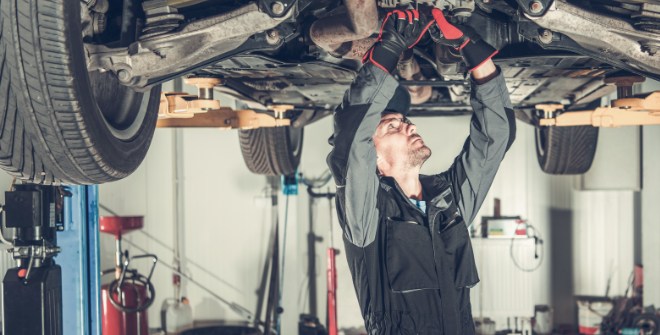Parts of an Ignition System & How They Work Together

Do you hear a clicking sound when you try to start your car? Does your engine sputter and then turn off? This could indicate a problem within your ignition system, which is responsible for starting your engine.
To help you understand how to detect the signs of an issue with your ignition system, Christian Brothers Automotive is here to help you understand what makes it different from a starter, what parts make up the system, and how they all work together to start your car when you turn your key.
What's the Difference Between an Ignition Switch & Starter?
A starter and an ignition switch are two separate parts, yet both play a vital role in starting your car's engine. The ignition switch activates the starter by providing it with power from the battery, and the starter is a motor responsible for rotating the crankshaft in order to start the engine.
An ignition switch controls other electrical components as well, such as headlights, wipers, and the car's audio system. While some vehicles have a manual key-type ignition switch, modern models typically feature electronic versions operated remotely or by a push-start button inside the vehicle's cabin.
The Parts of an Ignition System & How They Start Your Car
The main parts of an ignition system include a battery, ignition switch, resistor, ignition coil, points, rotor, distributor housing, distributor cap, and spark plugs. Here's a breakdown of each part and how they contribute to the ignition system.
Battery
The battery is an essential ignition system component, providing the power needed to start a vehicle. The battery supplies the power to turn over the engine's internal combustion process and gets your car going.
You may experience difficulties turning over your engine without a properly functioning battery. This is another reason why keeping your battery in good condition is so important!
Ignition Switch
The ignition switch is responsible for starting a car. It connects the battery and the starter motor, allowing power to flow when the key is turned.
When the switch is engaged, or you turn your keys, it sends a signal to the starter relay, telling the starter motor to engage and turn over the engine, beginning the car's internal combustion process. Without an ignition switch, there would be no way to connect or disconnect power from the battery, meaning your car would never start! Think of it like a light switch; the power is ready and available, you just have to flip the switch to turn it on.
Resistor
The resistor regulates your ignition system, as it helps control the amount of current allowed to pass through the wire coils. It decreases resistance value at appropriate times, allowing for a smooth start-up. This is similar to the purpose of a transmission in that the transmission regulates the power from the engine and distributes it appropriately.
It also helps protect the ignition system from power fluctuations and other unwanted electrical interference. Without a resistor, the wires would be subjected to too much current, which could potentially cause damage to your vehicle's electrical components.
Ignition Coil
The ignition coil is an electrical component that transforms the low voltage from a car battery into thousands of volts to cause an electric spark in the spark plugs. It is made up of two wire coils, primary and secondary, which are responsible for generating this high-voltage current.
When the car's key is turned, the primary coil receives a low-voltage current from the battery and amplifies it to create thousands of volts. This high voltage passes through the secondary coil and then reaches the spark plugs, which ignite combustible fuel and air in the engine cylinders for combustion.
So…up to this point, the battery provides power, the ignition switch channels that power, the resistor controls and regulates the flow of that power, and the coils receive and amplify that power. Let’s keep going!
Points
The points control the flow of electricity from the battery to the coil. They are typically located between the distributor housing and the spark plug wires, and they are responsible for opening and closing a circuit that transmits power to the ignition system.
The points work by using a mechanical connection created when two metal surfaces come into contact with each other. When the points open, current is allowed to flow from the battery to the coil, and when they close, the power is shut off.
Rotor
The rotor sits atop a spinning shaft in your engine, distributing electricity from the distributor housing to each spark plug. It uses centrifugal force to send electricity to each spark plug in synchronization with the other ignition system components.
Distributor Housing & Cap
The distributor housing is a circular case that contains a shaft and rotor and is responsible for controlling electricity flow through the ignition system. It ensures that electricity is evenly distributed to all parts of your car's engine for optimal performance.
The distributor cap covers the rotor and helps keep it free of dirt, dust, and other particles which could potentially cause damage to the electrical components in your engine. As such, it must be kept clean so electricity can flow freely throughout the ignition system.
***Most cars today no longer have these breaker points, rotors, or distributors and rely on newer technology. Modern cars typically bypass these items and skip from the coils to the spark plugs. Points haven’t been used since the mid 70’s. Although it isn’t today’s technology, it’s fun to mention! Let’s keep going.
Spark Plugs
Finally, we come to the spark plugs, responsible for igniting combustible fuel and air in the engine cylinders. The spark plug has a metal tip connected to an electrode, and when electricity reaches it, a spark is created, igniting the mixture of fuel and air, which allows combustion to occur.
Spark plugs are very important to your car. Keeping your spark plugs clean and well-maintained is essential, as they can become clogged with dirt or oil over time. A dirty or worn-out spark plug will not be able to generate enough heat or sparks needed to ignite the fuel within your engine. The result is poor performance. Your owners manual will recommend how often you should have your spark plugs replaced, as they will wear out over time.
Need Help with Your Ignition System? Visit Our Local Auto Shop
Your car's ignition system is made up of several components that all work together to start your vehicle's internal combustion process. For this reason, it is important to ensure that each part remains in good condition to avoid any unwanted delays or surprises. We recommend having your spark plugs inspected every 30,000-60,000 miles and replaced every 100,000 miles (or according to the manufacturer’s recommendations). Because of new technology, inspections of your ignition system are primarily on an as-needed basis.
On the other hand, if you are experiencing issues with your car's ignition system, it is best to have a professional look at it as soon as possible. The experienced technicians at Christian Brothers Automotive can inspect your vehicle and help get it back on the road quickly and safely.
Need ignition system services? We're here to help – find your local auto repair shop!


[1].jpg)
sunwash-tech-with-customer.png)

